Piaget’s Theory
Jean Piaget’s studies of cognitive development are a testimony to how much one person can contribute to a scientific field. Before his work began to appear in the early 1920s, there was no recognizable field of cognitive development. Nearly a century later, Piaget’s theory remains the best-known cognitive developmental theory in a field replete with theories. What accounts for its longevity?
One reason is that Piaget’s observations and descriptions vividly convey the texture of children’s thinking at different ages. Another reason is the exceptional breadth of the theory. It extends from the first days of infancy through adolescence and examines topics as diverse as conceptualization of time, space, distance, and number; language use; memory; understanding of other people’s perspectives; problem solving; and scientific reasoning. Even today, it remains the most encompassing theory of cognitive development. A third source of its longevity is that it offers an intuitively plausible depiction of the interaction of nature and nurture in cognitive development, as well as of the continuities and discontinuities that characterize intellectual growth.
View of Children’s Nature
Piaget’s fundamental assumption about children was that they are mentally active as well as physically active from the moment of birth, and that their activity greatly contributes to their own development. His approach to understanding cognitive development is often labeled constructivist, because it depicts children as constructing knowledge for themselves in response to their experiences. Three of the most important of children’s constructive processes, according to Piaget, are generating hypotheses, performing experiments, and drawing conclusions from their observations. If this description reminds you of scientific problem solving, you are not alone: the “child as scientist” is the dominant metaphor in Piaget’s theory. Consider this description of his infant son:
Laurent is lying on his back…. He grasps in succession a celluloid swan, a box, etc., stretches out his arm and lets them fall. He distinctly varies the position of the fall. When the object falls in a new position (for example, on his pillow), he lets it fall two or three more times on the same place, as though to study the spatial relation.
(Piaget, 1952b, pp. 268–269)
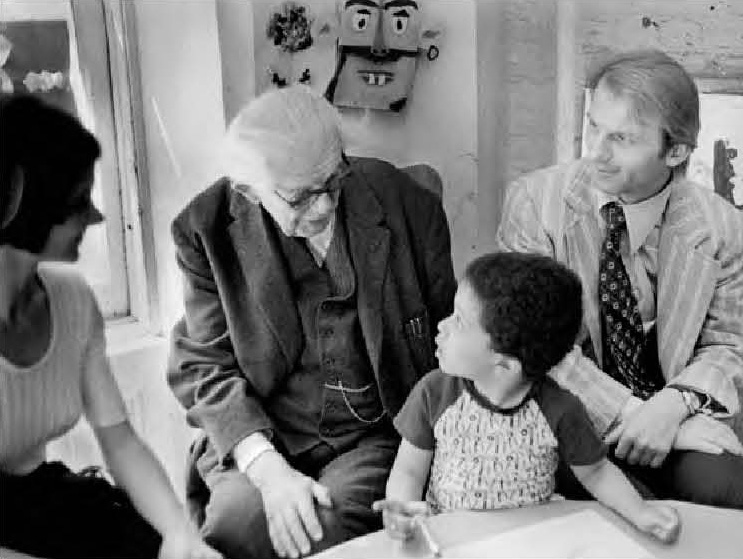
In simple activities such as Laurent’s game of “drop the toy from different places and see what happens,” Piaget perceived the beginning of scientific experimentation.
This example also illustrates a second basic Piagetian assumption: children learn many important lessons on their own, rather than depending on instruction from adults or older children. To further illuminate this point, Piaget cited a friend’s recollection from childhood:
He was seated on the ground in his garden and he was counting pebbles. Now to count these pebbles he put them in a row and he counted them one, two, three up to 10. Then he finished counting them and started to count them in the other direction. He began by the end and once again he found that he had 10. He found this marvelous…. So he put them in a circle and counted them that way and found 10 once again.
(Piaget, 1964, p. 12)
133
This incident also highlights a third basic assumption of Piaget’s: children are intrinsically motivated to learn and do not need rewards from other people to do so. When they acquire a new capability, they apply it as often as possible. They also reflect on the lessons of their experience, because they want to understand themselves and everything around them.
Central Developmental Issues
In addition to his view that children actively shape their own development, Piaget offered important insights regarding the roles of nature and nurture and of continuities and discontinuities in development.
Nature and Nurture
Piaget believed that nature and nurture interact to produce cognitive development. In his view, nurture includes not just the nurturing provided by parents and other caregivers but every experience children encounter. Nature includes children’s maturing brain and body; their ability to perceive, act, and learn from experience; and their tendency to integrate particular observations into coherent knowledge. As this description suggests, a vital part of children’s nature is to respond to their nurture.
Sources of Continuity
Piaget depicted development as involving both continuities and discontinuities. The main sources of continuity are three processes—assimilation, accommodation, and equilibration—that work together from birth to propel development forward.
assimilation  the process by which people translate incoming information into a form that fits concepts they already understand
the process by which people translate incoming information into a form that fits concepts they already understand
Assimilation is the process by which people incorporate incoming information into concepts they already understand. To illustrate, when one of our children was 2 years old, he saw a man who was bald on top of his head and had long frizzy hair on the sides. To his father’s great embarrassment, the toddler gleefully shouted, “Clown! Clown!” (Actually, it sounded more like “Kown! Kown!”) The man apparently looked enough like a “kown” that the boy could assimilate him to his clown concept.
accommodation  the process by which people adapt current knowledge structures in response to new experiences
the process by which people adapt current knowledge structures in response to new experiences
Accommodation is the process by which people improve their current understanding in response to new experiences. In the “kown” incident, the boy’s father explained to his son that the man was not a clown and that even though his hair looked like a clown’s, he was not wearing a funny costume and was not doing silly things to make people laugh. With this new information, the boy was able to accommodate his clown concept to the standard one, allowing other men with bald pates and long side hair to pass by in peace.
equilibration  the process by which children (or other people) balance assimilation and accommodation to create stable understanding
the process by which children (or other people) balance assimilation and accommodation to create stable understanding
Equilibration is the process by which children (indeed, people of all ages) balance assimilation and accommodation to create stable understanding. Equilibration includes three phases. First, children are satisfied with their understanding of a particular phenomenon; Piaget labeled this a state of equilibrium, because the children do not see any discrepancies between their observations and their understanding of the phenomenon. Then, new information leads them to perceive that their understanding is inadequate. Piaget said that this realization puts children in a state of disequilibrium; they recognize shortcomings in their understanding of the phenomenon, but they cannot generate a superior alternative. Finally, they develop a more sophisticated understanding that eliminates the shortcomings of the old one, creating a more advanced equilibrium within which a broader range of observations can be understood.

134
One example of how equilibration works involves the belief—held by most 4- to 7-year-olds in a wide range of cultures (Inagaki & Hatano, 2008)—that animals are the only living things. This belief seems to stem from the assumption that only animals can move in ways that help them survive. Sooner or later, children realize that plants also move in ways that promote their survival (e.g., toward sunlight). This new information is difficult for them to assimilate to their prior thinking. The resulting disparity between their previous understanding of living things and their new knowledge about plants creates a state of disequilibrium, in which they are unsure of what it means to be alive. Later, their thinking accommodates to the new information about plants. That is, they realize that both animals and plants move in adaptive ways and that, because adaptive movement is a key characteristic of living things, plants as well as animals must be alive (Opfer & Gelman, 2001; Opfer & Siegler, 2004). This realization constitutes a more stable equilibrium, because subsequent information about plants and animals will not contradict it. Through innumerable such equilibrations, children acquire knowledge of the world around them.
Sources of Discontinuity
Although Piaget placed some emphasis on continuous aspects of cognitive development, the most famous part of his theory concerns discontinuous aspects, which he depicted as distinct stages of cognitive development. Piaget viewed these stages as products of the basic human tendency to organize knowledge into coherent structures. Each stage represents a coherent way of understanding one’s experience, and each transition between stages represents a discontinuous intellectual leap from one coherent way of understanding the world to the next, higher one. The following are the central properties of Piaget’s stage theory:
1. Qualitative change. Piaget believed that children of different ages think in qualitatively different ways. For example, he proposed that children in the early stages of cognitive development conceive of morality in terms of the consequences of a person’s behavior, whereas children in later stages conceive of it in terms of the person’s intent. Thus, a 5-year-old would judge someone who accidentally broke a whole jar of cookies as having been naughtier than someone who deliberately stole a single cookie; an 8-year-old would reach the opposite conclusion. This difference represents a qualitative change, because the two children are basing their moral judgments on entirely different criteria.
2. Broad applicability. The type of thinking characteristic of each stage influences children’s thinking across diverse topics and contexts.
3. Brief transitions. Before entering a new stage, children pass through a brief transitional period in which they fluctuate between the type of thinking characteristic of the new, more advanced stage and the type of thinking characteristic of the old, less advanced one.
4. Invariant sequence. Everyone progresses through the stages in the same order without skipping any of them.
Piaget hypothesized four stages of cognitive development: the sensorimotor stage, the preoperational stage, the concrete operational stage, and the formal operational stage. In each stage, children exhibit new abilities that allow them to understand the world in qualitatively different ways than they had previously.
sensorimotor stage  the period (birth to 2 years) within Piaget’s theory in which intelligence is expressed through sensory and motor abilities
the period (birth to 2 years) within Piaget’s theory in which intelligence is expressed through sensory and motor abilities
135
- In the sensorimotor stage (birth to age 2 years), infants’ intelligence is expressed through their sensory and motor abilities, which they use to perceive and explore the world around them. These abilities allow them to learn about objects and people and to construct rudimentary forms of fundamental concepts such as time, space, and causality. Throughout the sensorimotor period, infants live largely in the here and now: their intelligence is bound to their immediate perceptions and actions.
preoperational stage
 the period (2 to 7 years) within Piaget’s theory in which children become able to represent their experiences in language, mental imagery, and symbolic thought
the period (2 to 7 years) within Piaget’s theory in which children become able to represent their experiences in language, mental imagery, and symbolic thought - In the preoperational stage (ages 2 to 7 years), toddlers and preschoolers become able to represent their experiences in language and mental imagery. This allows them to remember the experiences for longer periods and to form more sophisticated concepts. However, as suggested by the term preoperational, Piaget’s theory emphasizes young children’s inability to perform certain mental operations, such as considering multiple dimensions simultaneously. This leads to children’s being unable to form certain ideas, such as the idea that pouring all the water from a short, wide glass into a taller, narrower glass does not change the total amount of water, even though the column of water is higher in the second glass. In other words, they do not recognize that the increased height of the liquid column in the second glass is compensated for by its narrower width.
concrete operational stage
 the period (7 to 12 years) within Piaget’s theory in which children become able to reason logically about concrete objects and events
the period (7 to 12 years) within Piaget’s theory in which children become able to reason logically about concrete objects and events - In the concrete operational stage (ages 7 to 12 years), children can reason logically about concrete objects and events; for example, they understand that pouring water from one glass to a taller, narrower one leaves the amount of water unchanged. However, concrete operational reasoners cannot think in purely abstract terms or generate systematic scientific experiments to test their beliefs.
- In the final stage of cognitive development, the formal operational stage (age 12 years and beyond), children can think deeply not only about concrete events but also about abstractions and purely hypothetical situations. They also can perform systematic scientific experiments and draw appropriate conclusions from them, even when the conclusions differ from their prior beliefs.
formal operational stage
 the period (12 years and beyond) within Piaget’s theory in which people become able to think about abstractions and hypothetical situations
the period (12 years and beyond) within Piaget’s theory in which people become able to think about abstractions and hypothetical situations
With this overview of Piaget’s theory, we can consider in greater depth major changes that take place in each stage.
The Sensorimotor Stage (Birth to Age 2 Years)
One of Piaget’s most profound insights was his realization that the roots of adult intelligence are present in infants’ earliest behaviors, such as their seemingly aimless sucking, flailing, and grasping. He recognized that these behaviors are not random but instead reflect an early type of intelligence involving sensory and motor activity. Indeed, many of the clearest examples of the active child theme come from Piaget’s descriptions of the development of what he called “sensorimotor intelligence.”
Over the course of the first 2 years, infants’ sensorimotor intelligence develops tremendously. The sheer amount of change may at first seem astonishing. However, when we consider the immense variety of new experiences that infants encounter during this period, and the tripling of brain weight between birth and age 3 (with weight being an index of brain development during this period), the huge increase in infants’ cognitive abilities is more understandable. The profound developments that Piaget described as occurring during infancy call attention to a general principle: children’s thinking grows especially rapidly in the first few years.
136
Infants are born with many reflexes. When objects move in front of their eyes, they visually track them; when objects are placed in their mouths, they suck them; when objects come into contact with their hands, they grasp them; when they hear noises, they turn toward them; and so on. Piaget believed that these simple reflexes and perceptual abilities are the foundation of intelligence.
Even during their first month, infants begin to modify their reflexes to make them more adaptive. At birth, for example, they suck in a similar way regardless of what they are sucking. Within a few weeks, however, they adjust their sucking according to the object in their mouth. Thus, they suck on a milk-yielding nipple in a way that enhances the efficiency of their feeding and that is different from the way they suck on a finger or even a pacifier. As this example illustrates, from the first days out of the womb, infants accommodate their actions to the parts of the environment with which they interact.
Over the course of the first few months, infants begin to organize separate reflexes into larger behaviors, most of which are centered on their own bodies. For example, instead of being limited to exercising their grasping and sucking reflexes separately, they can integrate them: when an object touches their palm, they can grasp it, bring it to their mouth, and suck on it. Thus, their reflexes serve as building blocks for more complex behaviors.
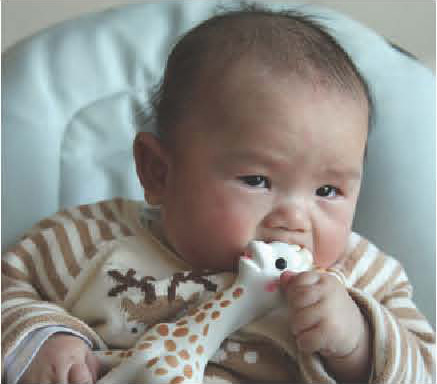
In the middle of their first year, infants become increasingly interested in the world around them—people, animals, toys, and other objects and events beyond their own bodies. A hallmark of this shift is their repetition of actions on the environment that produce pleasurable or interesting results. Repeatedly banging a rattle and squeezing a rubber duck again and again to make it squeak are examples of favorite activities for many infants at this time.
object permanence  the knowledge that objects continue to exist even when they are out of view
the knowledge that objects continue to exist even when they are out of view
Piaget (1954) made a striking and controversial claim about a deficiency in infants’ thinking during this period—the one referred to in the chapter-opening anecdote about the father hiding his glasses. The claim was that through the age of 8 months, infants lack object permanence, the knowledge that objects continue to exist even when they are out of view. This claim was based largely on Piaget’s observations of his own children, Laurent, Lucienne, and Jacqueline. The following account of an experiment with Laurent reflects the type of observation that inspired Piaget’s belief about object permanence:
At age 7 months, 28 days, I offer him a little bell behind a cushion. So long as he sees the little bell, however small it may be, he tries to grasp it. But if the little bell disappears completely he stops all searching. I then resume the experiment using my hand as a screen. Laurent’s arm is outstretched and about to grasp the little bell at the moment I make it disappear behind my hand which is open and at a distance of about 15 cm from him. He immediately withdraws his arm, as though the little bell no longer existed.
(Piaget, 1954, p. 39)
Thus, in Piaget’s view, for infants younger than 8 months, the adage “out of sight, out of mind” is literally true. They are able to mentally represent (think about) only the objects that they can perceive at the moment.
A-not-B error  the tendency to reach for a hidden object where it was last found rather than in the new location where it was last hidden
the tendency to reach for a hidden object where it was last found rather than in the new location where it was last hidden
By the end of the first year, infants search for hidden objects, thus indicating that they mentally represent the objects’ continuing existence even when they no longer see them. These initial representations of objects are fragile, however, as reflected in the A-not-B error. In this error, once 8- to 12-month-olds have reached for and found a hidden object several times in one place (location A), when they see the object hidden at a different place (location B) and are prevented from immediately searching for it, they tend to reach where they initially found the object (location A) (see Figure 4.1). Not until around their first birthday do infants consistently search first at the object’s current location.
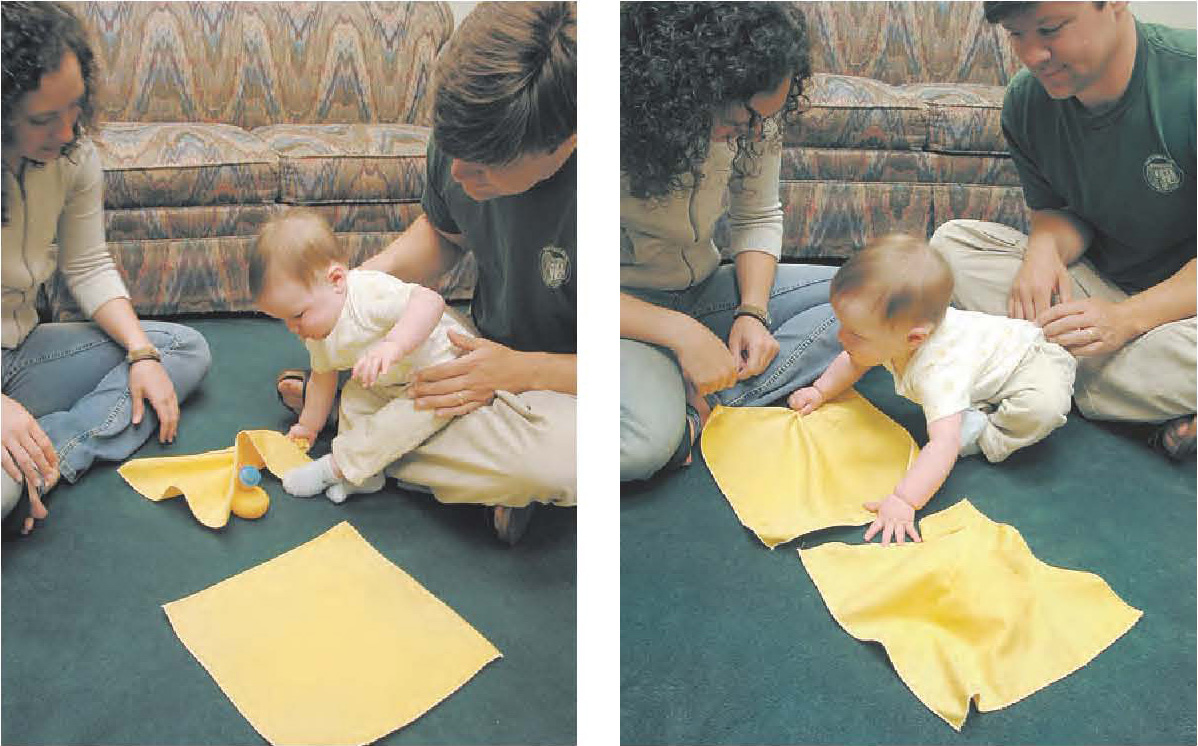
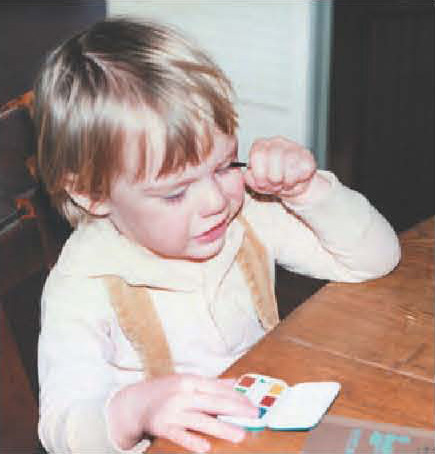
137
At around 1 year of age, infants begin to actively and avidly explore the potential ways in which objects can be used. The “child as scientist” example presented earlier, in which Piaget’s son Laurent varied the positions from which he dropped different objects to see what would happen, provides one instance of this emerging competency. Similar examples occur in every family with an infant. Few parents forget their 12- to 18-month-old sitting in a high chair, banging various objects against the chair’s tray—first a spoon, then a plate, then a cup—seemingly fascinated by the sounds made by the different objects. Nor do they forget their infant dropping bathroom articles into the toilet, or pouring a bag of flour on the kitchen floor, just to see what happens. Piaget regarded such actions as the beginnings of scientific experimentation (many parents see such behaviors in less positive terms).
deferred imitation  the repetition of other people’s behavior a substantial time after it originally occurred
the repetition of other people’s behavior a substantial time after it originally occurred
In the last half-year of the sensorimotor stage (ages 18 to 24 months), according to Piaget, infants become able to form enduring mental representations. The first sign of this new capability is deferred imitation, that is, the repetition of other people’s behavior minutes, hours, or even days after it occurred. Consider Piaget’s observation of 1-year-old Jacqueline:
Jacqueline had a visit from a little boy…who, in the course of the afternoon, got into a terrible temper. He screamed as he tried to get out of a playpen and pushed it backward, stamping his feet…. The next day, she herself screamed in her playpen and tried to move it, stamping her foot lightly several times in succession.
(Piaget, 1951, p. 63)
Piaget indicated that Jacqueline had never before thrown such a tantrum. Presumably, she had watched and remembered her playmate’s behavior, maintained a representation of it overnight, and imitated it the next day.
138
When we consider Piaget’s account of cognitive development during infancy, several notable trends are evident.
 At first, infants’ activities center on their own bodies; later, their activities include the world around them.
At first, infants’ activities center on their own bodies; later, their activities include the world around them. Early goals are concrete (shaking a rattle and listening to the sound it makes); later goals often are more abstract (varying the heights from which objects are dropped and observing how the effects vary).
Early goals are concrete (shaking a rattle and listening to the sound it makes); later goals often are more abstract (varying the heights from which objects are dropped and observing how the effects vary). Infants become increasingly able to form mental representations, moving from “out of sight, out of mind” to remembering a playmate’s actions from a full day earlier. Such enduring mental representations make possible the next stage, which Piaget called preoperational thinking.
Infants become increasingly able to form mental representations, moving from “out of sight, out of mind” to remembering a playmate’s actions from a full day earlier. Such enduring mental representations make possible the next stage, which Piaget called preoperational thinking.
The Preoperational Stage (Ages 2 to 7)
Piaget viewed the preoperational period as including a mix of striking cognitive acquisitions and fascinating limitations. Perhaps the foremost acquisition is the development of symbolic representations; among the most notable weaknesses are egocentrism and centration.
Development of Symbolic Representations
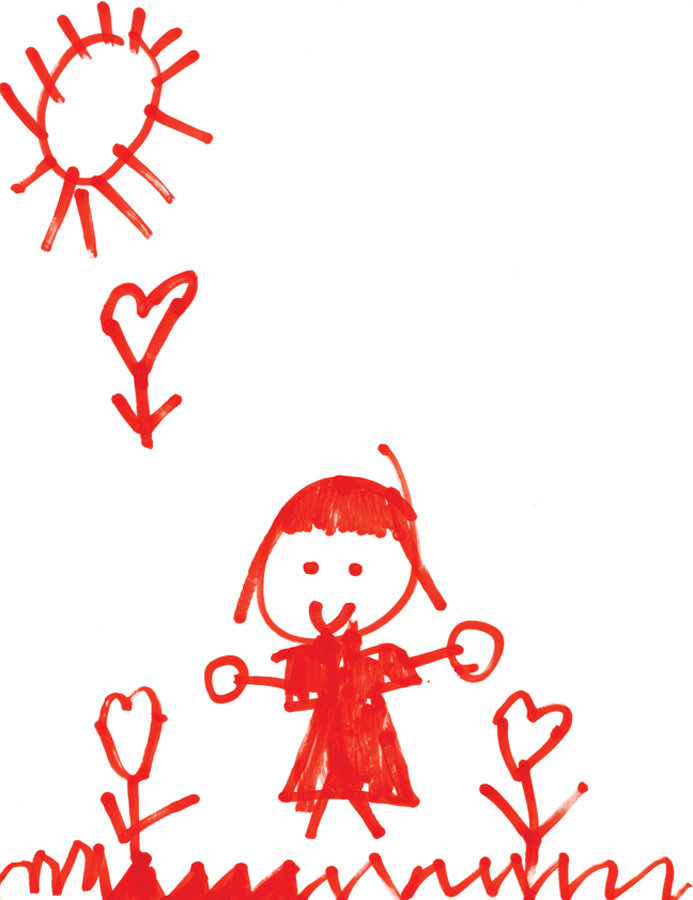
symbolic representation  the use of one object to stand for another
the use of one object to stand for another
Have you ever seen preschoolers use two Popsicle sticks to represent a gun or a playing card to represent an iPhone? Forming such personal symbols is common among 3- to 5-year-olds. It is one of the ways in which they exercise their emerging capacity for symbolic representation—the use of one object to stand for another. Typically, these personal symbols physically resemble the objects they represent. The Popsicle sticks’ and playing card’s shapes somewhat resemble those of a gun and iPhone.
As children develop, they rely less on self-generated symbols and more on conventional ones. For example, when 5-year-olds play games involving pirates, they might wear a patch over one eye and a bandanna over their head because that is the way pirates are commonly depicted. Heightened symbolic capabilities during the preoperational period are also evident in the growth of drawing. Children’s drawings between ages 3 and 5 make increasing use of symbolic conventions, such as representing the leaves of flowers as Vs (Figure 4.2).
Egocentrism
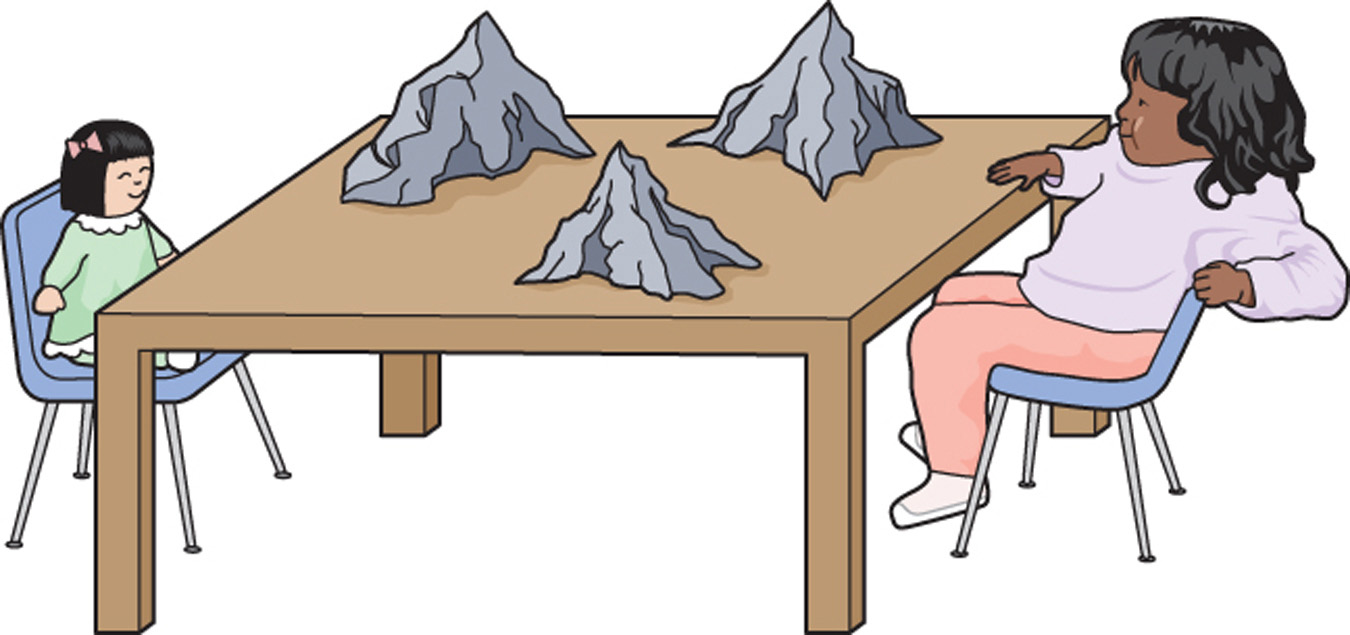
egocentrism  the tendency to perceive the world solely from one’s own point of view
the tendency to perceive the world solely from one’s own point of view
Although Piaget noted important growth in children’s thinking during the preoperational stage, he found the limitations of this period to be as intriguing and revealing of preoperational understanding. As noted, one important limitation is egocentrism, that is, perceiving the world solely from one’s own point of view. An example of this limitation involves preschoolers’ difficulty in taking other people’s spatial perspectives. Piaget and Inhelder (1956/1977) demonstrated this difficulty by having 4-year-olds sit at a table in front of a model of three mountains of different sizes (Figure 4.3). The children were asked to identify which of several photographs depicted what a doll would see if it were sitting on chairs at various locations around the table. Solving this problem required children to recognize that their own perspective was not the only one possible and to imagine what the view would be from another location. Most 4-year-olds, according to Piaget, cannot do this.
139
The same difficulty in taking other people’s perspectives is seen in quite different contexts—for example, in communication. As illustrated in Figure 4.4, preschoolers often talk right past each other, focused only on what they themselves are saying and seemingly oblivious to their partner’s comments. Preschoolers’ egocentric communication also is evident when they make statements that require knowledge that they themselves possess but that their listeners couldn’t be expected to have. For example, 2- and 3-year-olds frequently tell day-care providers and parents things like “He took it from me,” in situations where the person or object to which the child is referring is totally unclear. Egocentric thinking is also evident in preschoolers’ explanations of events and behavior. Consider the following interviews with preschoolers that occurred in the original version of the TV show Kids Say the Darndest Things:
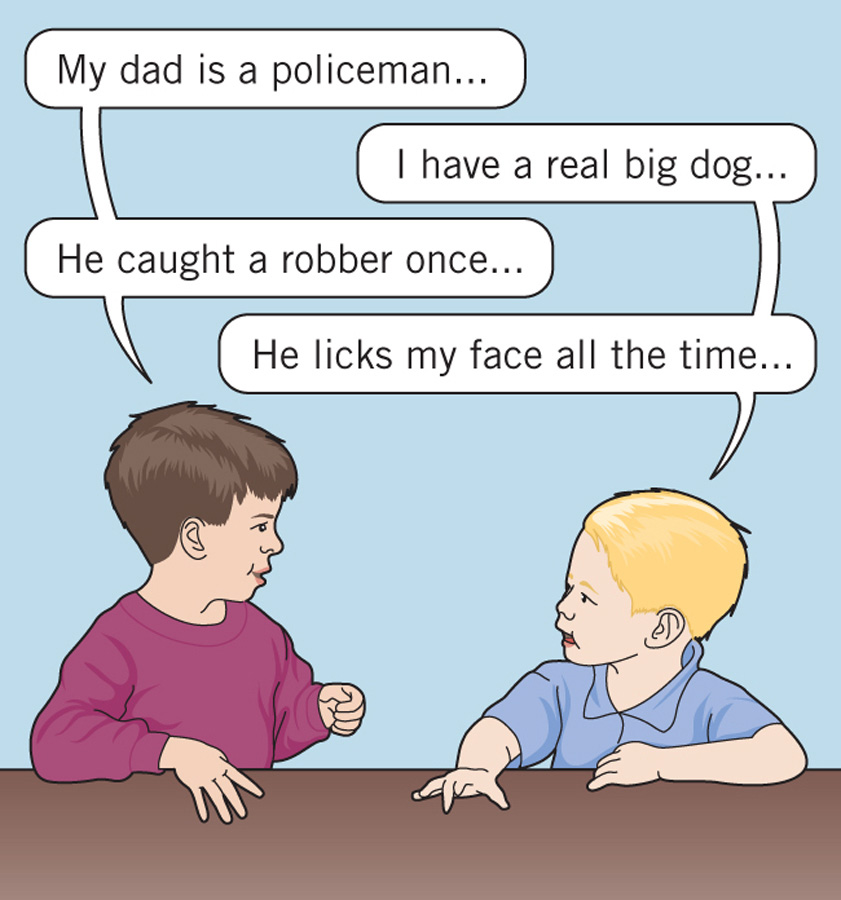
- Interviewer: Any brothers or sisters?
- Child: I have a brother a week old.
- I: What can he do?
- C: He can say “Mamma” and “Daddy.”
- I: Can he walk?
- C: No, he’s too lazy.
- Interviewer: Any brothers or sisters?
- Child: A 2-months-old brother.
- I: How does he behave?
- C: He cries all night.
- I: Why is that, do you think?
- C: He probably thinks he’s missing something on television.
(Linkletter, 1957, p. 6)
Over the course of the preoperational period, egocentric speech becomes less common. An early sign of progress is children’s verbal quarrels, which become increasingly frequent during this period. The fact that a child’s statements elicit a playmate’s objection indicates that the playmate is at least paying attention to the differing perspective that the other child’s comment implies. Children also become better able to envision spatial perspectives other than their own during the preoperational period. We all remain somewhat egocentric throughout our lives, but most of us do improve.
Centration

centration  the tendency to focus on a single, perceptually striking feature of an object or event
the tendency to focus on a single, perceptually striking feature of an object or event
A related limitation of preschoolers’ thinking is centration, that is, focusing on a single, perceptually striking feature of an object or event to the exclusion of other relevant but less striking features. Children’s approaches to balance-scale problems provide a good example of centration. If presented with a balance scale like that in Figure 4.5 and asked which side will go down, 5- and 6-year-olds center on the amount of weight on each side, ignore the distance of the weights from the fulcrum, and say that whichever side has more weight will go down (Inhelder & Piaget, 1958).
conservation concept  the idea that merely changing the appearance of objects does not necessarily change other key properties
the idea that merely changing the appearance of objects does not necessarily change other key properties
Another good example of centration comes from Piaget’s research on children’s understanding of conservation. The idea of the conservation concept is that merely changing the appearance or arrangement of objects does not necessarily change other key properties, such as quantity of material. Three variants of the concept that are commonly studied in 5- to 8-year-olds are conservation of liquid quantity, conservation of solid quantity, and conservation of number (Piaget, 1952a). In all three cases, the tasks used to measure children’s understanding employ a three-phase procedure (Figure 4.6). First, as in the figure, children are shown two objects (e.g., two glasses of orangeade, two clay sausages) that are identical in quantity, or two sets of objects (e.g., two rows of pennies) that are identical in number. Once children agree that the dimension of interest (e.g., the amount of orangeade or the number of pennies) is equal in both items, they observe a second phase in which the experimenter transforms one object or set of objects in a way that makes it look different but does not change the dimension of interest. Orangeade might be poured into a taller, narrower, glass; a short, thick clay sausage might be molded into a long, thin sausage; or one of the two rows of pennies might be spread out. Finally, in the third phase, children are asked whether the dimension of interest, which they earlier had said was equal for the two objects or sets of objects, is still equal.
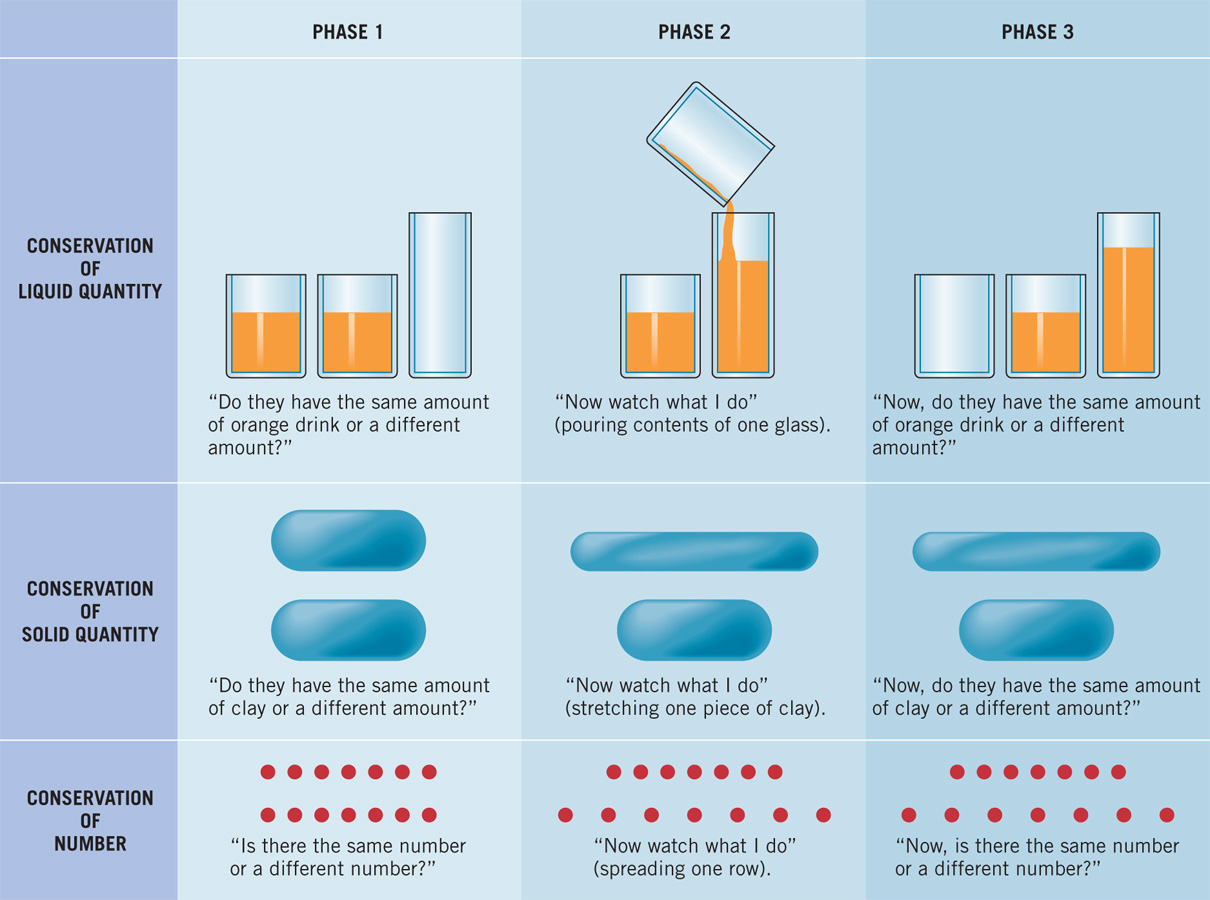
140
The large majority of 4- and 5-year-olds answer “no.” On conservation-of-liquid-quantity problems, they claim that the taller, narrower glass has more orangeade; on conservation-of-solid-quantity problems, they claim that the long, thin sausage has more clay than the short, thick one; and so on. Children of this age make similar errors in everyday contexts; for example, they often think that if a child has one fewer cookie than another child, a fair solution is to break one of the short-changed child’s cookies into two pieces (Miller, 1984).
A variety of weaknesses that Piaget perceived in preoperational thinking contribute to these difficulties with conservation problems. Preoperational thinkers center their attention on the single, perceptually salient dimension of height or length, ignoring other relevant dimensions. In addition, their egocentrism leads to their failing to understand that their own perspective can be misleading—that just because a tall narrow glass of orangeade or a long thin clay sausage looks as though it has more orangeade or clay than a shorter, wider one does not mean that it really does. Children’s tendency to focus on static states of objects (the appearance of the objects after the transformation) and to ignore the transformation that was performed (pouring the orangeade or reshaping the clay) also contributes to their difficulty in solving conservation problems.
141
In the next period of cognitive development, the concrete operational stage, children largely overcome these and other related limitations.
The Concrete Operational Stage (Ages 7 to 12)

At around age 7, according to Piaget, children begin to reason logically about concrete features of the world. Development of the conservation concept exemplifies this progress. Although few 5-year-olds solve any of the three conservation tasks described in the previous section, most 7-year-olds solve all of them. The same progress in thinking also allows children in the concrete operational stage to solve many other problems that require attention to multiple dimensions. For example, on the balance-scale problem, they consider distance from the fulcrum as well as weight of objects.
However, this relatively advanced reasoning is, according to Piaget, limited to concrete situations. Thinking systematically remains very difficult, as does reasoning about hypothetical situations. These limitations are evident in the types of experiments that concrete operational children perform to solve the pendulum problem (Inhelder & Piaget, 1958) (Figure 4.7). In this problem, children are presented a pendulum frame, a set of strings of varying length with a loop at each end, and a set of metal weights of varying weight, any of which can be attached to any string. When the loop at one end of the string is attached to a weight, and the loop at the other end is attached to the frame of the pendulum, the string can be swung. The task is to perform experiments that indicate which factor or factors influence the amount of time it takes the pendulum to swing through a complete arc. Is it the length of the string, the heaviness of the weight, the height from which the weight is dropped, or some combination of these factors? Think for a minute: How would you go about solving this problem?
Most concrete operational children begin their experiments believing that the relative heaviness of the weights being dropped is the most important factor, perhaps the only important one. This belief is not unreasonable; indeed, most adolescents and adults share it. What distinguishes the children’s reasoning from that of older individuals is how they test their belief. Concrete operational reasoners design biased experiments from which no valid conclusion can be drawn. For example, they might compare the travel time of a heavy weight on a short string dropped from a high position to the travel time of a light weight on a long string dropped from a lower position. When the first string goes faster, they conclude that, just as they thought, heavy weights go faster. This premature conclusion, however, reflects their limited ability to think systematically or to imagine all possible combinations of variables. They fail to imagine that the faster motion might be related to the length of the string or the height from which the string was dropped, rather than the weight of the object.
The Formal Operational Stage (Age 12 and Beyond)
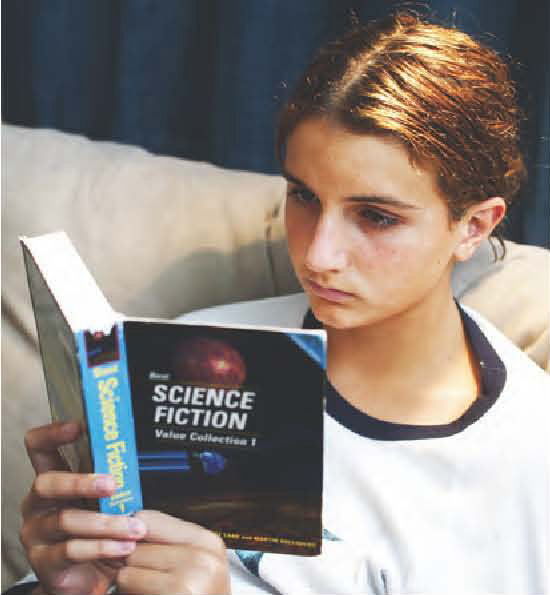
Formal operational thinking, which includes the ability to think abstractly and to reason hypothetically, is the pinnacle of the Piagetian stage progression. The difference between reasoning in this stage and in the previous one is clearly illustrated by formal operational reasoners’ approach to the pendulum problem. Framing the problem more abstractly than do children in the concrete operational stage, they see that any of the variables—weight, string length, and dropping point—might influence the time it takes for the pendulum to swing through an arc, and that it is therefore necessary to test the effect of each variable systematically. To test the effect of weight, they compare times to complete an arc for a heavier weight and a lighter weight, attached to strings of equal length and dropped from the same height. To test the effect of string length, they compare the travel times of a long and a short string, with equal weight dropped from the same position. To test the influence of dropping point, they vary the dropping point of a given weight attached to a given string. Such a systematic set of experiments allows the formal operational thinker to determine that the only factor that influences the pendulum’s travel time is the length of the string; neither weight nor dropping point matters.
142
Piaget believed that unlike the previous three stages, the formal operational stage is not universal: not all adolescents (or adults) reach it. For those adolescents who do reach it, however, formal operational thinking greatly expands and enriches their intellectual universe. Such thinking makes it possible for them to see the particular reality in which they live as only one of an infinite number of possible realities. This insight leads them to think about alternative ways that the world could be and to ponder deep questions concerning truth, justice, and morality. It no doubt also helps account for the fact that many people first acquire a taste for science fiction during adolescence. The alternative worlds depicted in science-fiction stories appeal to adolescents’ emerging capacity to think about the world they know as just one of many possibilities and to wonder whether a better world is possible.
The attainment of formal operational thinking does not mean that adolescents will always reason in advanced ways, but it does, according to Piaget, mark the point at which adolescents attain the reasoning powers of intelligent adults. (Some ways in which Piaget’s theory can be applied to improving education are discussed in Box 4.1.)
Piaget’s Legacy
Although much of Piaget’s theory was formulated many years ago, it remains a very influential approach to understanding cognitive development. Some of its strengths were mentioned earlier. It provides a good overview of children’s thinking at different points in development (Table 4.2). It includes countless fascinating observations. It offers a plausible and appealing perspective on children’s nature. It surveys a remarkably broad spectrum of developments and covers the entire age span from infancy through adolescence.
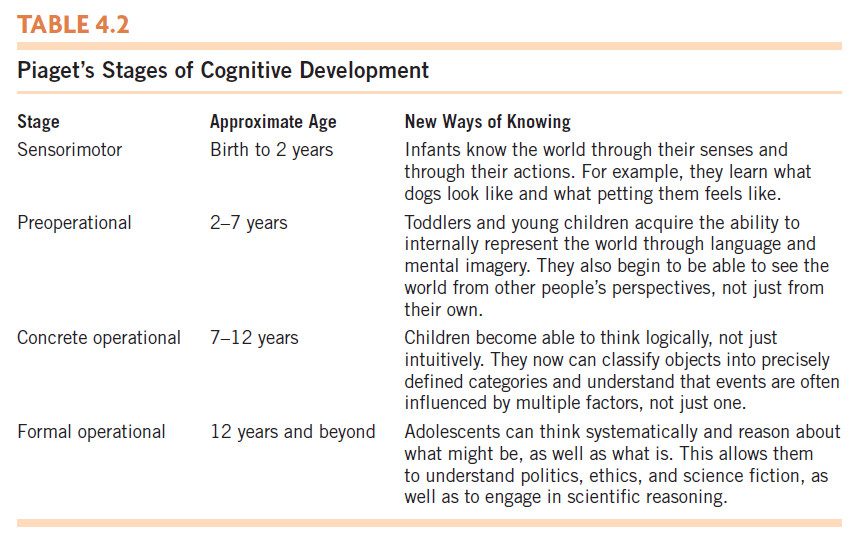
However, subsequent analyses (Flavell, 1971, 1982; Miller, 2011) have identified some crucial weaknesses in Piaget’s theory. The following four are particularly important:
1. The stage model depicts children’s thinking as being more consistent than it is. According to Piaget, once children enter a given stage, their thinking consistently shows the characteristics of that stage across diverse concepts. Subsequent research, however, has shown that children’s thinking is far more variable than this depiction suggests. For example, most children succeed on conservation-of-number problems by age 6, whereas most do not succeed on conservation-of-solid-quantity problems until age 8 or 9 (Field, 1987). Piaget recognized that such variability exists but underestimated its extent and failed to explain it.
143
Box 4.1: applications
Educational Applications of Piaget’s Theory
Piaget’s view of children’s cognitive development holds a number of general implications for how children should be educated (Case, 1998; Piaget, 1972). Most generally, it suggests that children’s distinctive ways of thinking at different ages need to be considered in deciding how to teach them. For example, children in the concrete operational stage would not be expected to be ready to learn purely abstract concepts such as inertia and equilibrium state, whereas adolescents in the formal operational stage would be. Taking into account such general age-related differences in cognitive level before deciding when to teach particular concepts is often labeled a “child-centered approach.”
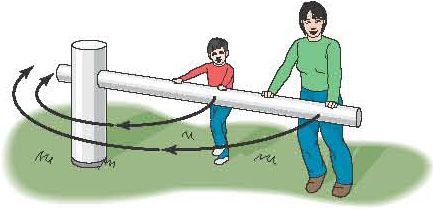
A second implication of Piaget’s approach is that children learn best by interacting with the environment, both mentally and physically. One research demonstration of this principle involved promoting children’s understanding of the concept of speed (Levin, Siegler, & Druyan, 1990). The investigation focused on problems of a type beloved by physics teachers: “When a race horse travels around a circular track, do its right and left sides move at the same speed?” It appears obvious that they do, but, in fact, they do not. The side toward the outside of the track is covering a slightly greater distance in the same amount of time as the side toward the inside and therefore is moving slightly faster.
Levin and her colleagues devised a procedure that allowed children to actively experience how different parts of a single object can move at different speeds. They attached one end of a 7-foot-long metal bar to a pivot that was mounted on the floor. One by one, 6th-graders and an experimenter took four walks around the pivot while holding onto the bar. On two of the walks, the child held the bar near the pivot and the experimenter held it at the far end; on the other two walks, they switched positions (see figure). After each walk, children were asked whether the inner or outer part of the bar had moved faster.
The differences in the speeds required for walking while holding the inner and the outer parts of the metal bar were so dramatic that the children generalized their new understanding to other problems involving circular motion, such as cars moving around circular tracks on a computer screen. In other words, physically experiencing the concept accomplished what years of formal science instruction usually fail to do. As one boy said to the experimenter, “Before, I hadn’t experienced it. I didn’t think about it. Now that I have had that experience, I know that when I was on the outer circle, I had to walk faster to be at the same place as you” (Levin et al., 1990). Clearly, relevant physical activities, accompanied by questions that call attention to the lessons of the activities, can foster children’s learning.
144
2. Infants and young children are more cognitively competent than Piaget recognized. Piaget employed fairly difficult tests to assess most of the concepts he studied. This led him to miss infants’ and young children’s earliest knowledge of these concepts. For example, Piaget’s test of object permanence required children to reach for the hidden object after a delay; Piaget claimed that children do not do this until 8 or 9 months of age. However, alternative tests of object permanence, which analyze where infants look immediately after the object has disappeared from view, indicate that by 3 months of age, even these young infants at least suspect that objects continue to exist (Baillargeon, 1987; 1993).
3. Piaget’s theory understates the contribution of the social world to cognitive development. Piaget’s theory focuses on how children come to understand the world through their own efforts. From the day that children emerge from the womb, however, they live in an environment of adults and older children who shape their cognitive development in countless ways. A child’s cognitive development reflects the contributions of other people, as well as of the broader culture, to a far greater degree than Piaget’s theory acknowledges.
4. Piaget’s theory is vague about the cognitive processes that give rise to children’s thinking and about the mechanisms that produce cognitive growth. Piaget’s theory provides any number of excellent descriptions of children’s thinking. It is less revealing, however, about the processes that lead children to think in a particular way and that produce changes in their thinking. Assimilation, accommodation, and equilibration have an air of plausibility, but how they operate is unclear.
These weaknesses of Piaget’s theory do not negate the magnitude of his achievement: it remains one of the major intellectual accomplishments of the past century. However, appreciating the weaknesses as well as the strengths of his theory is necessary for understanding why alternative theories of cognitive development have become increasingly prominent.
In the remainder of this chapter, we consider the three most prominent alternative theories: information-processing, sociocultural, and dynamic-systems. Each type of theory can be seen as an attempt to overcome a major weakness of Piaget’s approach. Information-processing theories emphasize precise characterizations of the processes that give rise to children’s thinking and the mechanisms that produce cognitive growth. Sociocultural theories emphasize the ways in which children’s interactions with the social world, both with other people and with the products of their culture, guide cognitive development. Dynamic-systems theories emphasize infants’ and young children’s developing physical and mental capabilities and how these capabilities are attained.
review:
Piaget’s theory of cognitive development emphasizes the interaction of nature and nurture, continuities and discontinuities, and children’s active contribution to their own development. The continuities of development are produced by assimilation, accommodation, and equilibration. Assimilation involves interpreting incoming information to fit current understanding. Accommodation involves adapting one’s thinking toward being more consistent with new experiences. Equilibration involves balancing assimilation and accommodation in a way that creates stable understandings.
As depicted by Piaget, the discontinuities of cognitive development involve four discrete stages: (1) the sensorimotor stage (birth to age 2), in which infants begin to know the world through the perceptions of their senses and through their motor activities; (2) the preoperational stage (ages 2 to 7), in which children become capable of mental representations but tend to be egocentric and to focus on a single dimension of an event or problem; (3) the concrete operational stage (ages 7 to 12), in which children reason logically about concrete aspects of the environment but have difficulty thinking abstractly; and (4) the formal operational stage (age 12 and beyond), in which preadolescents and adolescents become capable of abstract thought.
145
Among the important strengths of Piaget’s theory are its broad overview of development, its plausible and attractive perspective on children’s nature, its inclusion of varied tasks and age groups, and its endlessly fascinating observations. Among the theory’s important weaknesses are its overstatement of the consistency of children’s thinking, its underestimation of infants’ and young children’s cognitive competence, its lack of attention to the contribution of the social world, and its vagueness regarding cognitive mechanisms.
